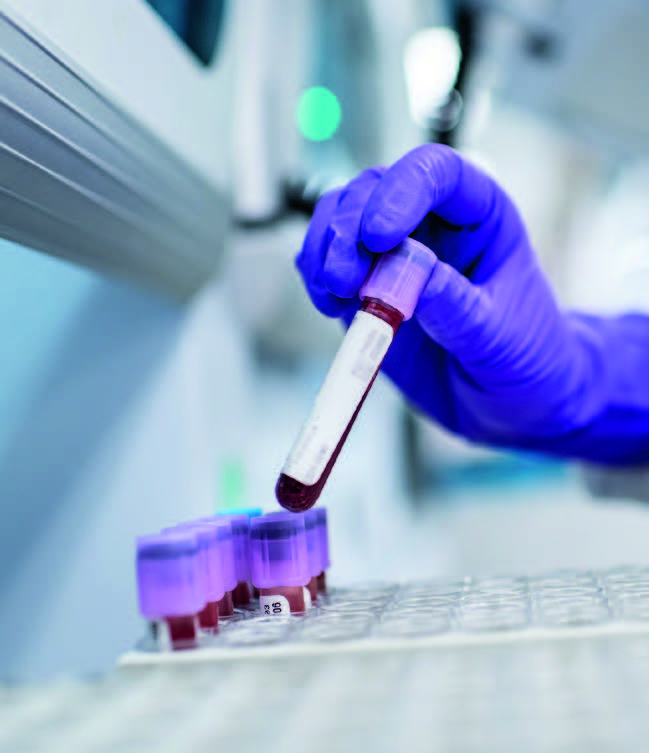There’s a lab for that: Innovative and enhanced diagnostics

THERE’S A LAB FOR THAT
Mayo Clinic Laboratories works relentlessly to bring innovative and enhanced diagnostics to patients
The flashiest medical news stories often revolve around treatments, with headlines heralding successful cancer vaccine trials, new Alzheimer’s disease medications and blockbuster diabetes drugs.
These achievements are certainly worth celebrating, as patients find relief from chronic and potentially fatal conditions. But this narrative tends to skip over an entire step in the advancement of healthcare: The path to appropriate, effective treatment starts with an accurate diagnosis.
“I’ve always been passionate that diagnostics and laboratories have such an importance in healthcare that’s often underrecognized,” says William Morice II, M.D., Ph.D. (MDPH ’94, IMM ’94, PATH ’98, SGPA ’99, HEMP ’00).
Dr. Morice is CEO and president of Mayo Clinic Laboratories (MCL), a diagnostic company and reference laboratory that offers a catalog of 4,400 tests and pathology services in partnership with the Department of Laboratory Medicine and Pathology at Mayo Clinic. That number continues to climb as MCL relentlessly innovates on behalf of patients through collaborations with Mayo Clinic physicians, other healthcare systems, biopharmaceutical companies and healthcare research organizations.
“When I look back across my career in medicine, just the pace of change and what’s happening now in diagnostics and healthcare, I don’t know if I would have conceived of these innovations back when I came to Mayo as an M.D.-Ph.D. student in 1987 or when I joined the Mayo Clinic staff in 2000,” says Dr. Morice.
Read on to learn about some of the latest labs that are improving the lives of patients around the world as MCL partners with Mayo Clinic innovators and others to bring new tests and solutions to the market.

William Morice II, M.D., Ph.D., CEO and president of Mayo Clinic Laboratories



CNS PATHOGEN TESTING: When a diagnosis is elusive
When a patient has a suspected central nervous system (CNS) infection, there’s often a very long list of possible causes, including bacteria, fungi, viruses and parasites — and limited time and means to narrow down the list of suspects.
The longer the infection goes untreated, the greater the risk of seizures, permanent physical and cognitive disabilities, and even death.
“Central nervous system infections can be devastating,” says Robin Patel, M.D. (I ’92, INFD ’95, CM ’96), a consultant in the Division of Clinical Microbiology and the Elizabeth P. and Robert E. Allen Professor of Individualized Medicine at Mayo Clinic in Minnesota. “For many, specific treatment is available. But we need to know what the diagnosis is so that we can deploy the right treatment. Therefore, the sooner we can make an accurate diagnosis, the better.”
Standard laboratory tests can identify many — but not all — of these infections.
“The need for better diagnostics is compelling, because there’s little room for error or waiting with central nervous system infections,” says Dr. Patel. “No one wants a poor outcome of a brain infection that could have been cured but wasn’t because a correct diagnosis wasn’t made.”
To prevent these poor outcomes, MCL offers standard and sophisticated tests for CNS infections — including a metagenomic assay recently developed at Mayo Clinic that can identify more than 1,000 pathogenic organisms in cerebrospinal fluid (CSF).
THE USUAL SUSPECTS
Finding the cause of a CNS infection typically involves running a spate of tests on CSF, including cell count and differential, protein and glucose concentrations, along with cultures — which only detect live organisms — and antigen and polymerase chain reaction (PCR) tests — which detect targeted microorganisms.
MCL offers a multiplex PCR pathogen panel that can rapidly detect the nucleic acid of 14 of the most common causes of meningitis and encephalitis. Even so, running all these tests may leave the patient and physician without answers.
“Some disease-causing microorganisms are so unusual that we don’t have a commonly used diagnostic for them,” Dr. Patel says.
In these cases, MCL’s metagenomic assay may be a strategic next step. Using a patient’s CSF and a technique known as metagenomic sequencing, the test extracts every bit of nucleic acid in the CSF sample. The nucleic acid DNA is directly sequenced, and the nucleic acid RNA is converted to DNA and sequenced. Then a complex bioinformatic analysis is used to remove human sequences, and the remainder of the sequences are analyzed to determine whether there is evidence for the presence of potentially pathogenic microorganisms.
“A metagenomic approach for infectious diseases diagnosis allows us to look for potential pathogens without the bias of having to think about which type of organism this might be and ordering a specific diagnostic test,” says Dr. Patel. “It opens the door for us to ask open-ended questions.”
Dr. Patel worked with senior developer Matt Wolf, Department of Laboratory Medicine and Pathology at Mayo Clinic in Minnesota, to develop the assay — an example of team-based innovation advancing diagnostics. Test developers, clinician-researchers, laboratory technologists and microbiology experts at Mayo Clinic regularly collaborate to run experiments, review and interpret assay results, and recommend treatment approaches. MCL is then able to make those innovations broadly available to clinicians around the world to better care for patients.
“Operationalizing technological advances for clinical use requires a dedicated team to design and build our tests, validate them and standardize them in a way that they can be handed off to the clinical laboratory to run. Not every institution in the United States or in the world has that kind of operational setup,” Dr. Patel says.

LUPUS TESTING: Transforming the patient experience
As a rheumatologist and lupus researcher, Donald Thomas, M.D., knows how difficult it is to put lupus in a box.
“If I lined up 100 of my patients, every single one of them would be different,” says Dr. Thomas. “One person might come into the hospital with blood clots and a stroke and fatigue. Someone else might have a lot of protein in their urine and chest pain from pleurisy. Someone else could just have some low blood counts picked up on some routine tests but feel amazing.”
Systemic lupus erythematosus (SLE) is an autoimmune disease that can attack multiple organ systems, often at the same time. This results in a wide variety of clinical manifestations that may overlap with other autoimmune diseases like rheumatoid arthritis, fibromyalgia and Sjögren’s disease.
Management of lupus can be complicated. For many, the disease waxes and wanes, and severe flares can require hospitalization and medications like immuno- suppressants and corticosteroids to bring them under control — all of which increase the risk of permanent organ damage.
Yet, there’s no definitive, single laboratory test that can classify a patient as having SLE, measure disease activity, or predict or assess a disease flare. Dr. Thomas doesn’t mince words: the traditional laboratory tests for lupus are “downright horrible,” he says.
“I just think any disease that can take several years to diagnose, it just screams to me we have to continue to innovate to get better tools,” says Dr. Morice. “From a laboratory and a clinical perspective, it’s something we should really be vigilant and passionate about for the sake of our patients.”
To that end, Mayo Clinic Laboratories teamed up with Progentec Diagnostics, a digital health and biomarker technology-based company focused on autoimmune conditions, to increase testing accessibility for providers and patients across the U.S. and select global markets. Progentec has produced two biomarker blood tests for proactive lupus management that characterize disease activity and flare risk.
MITIGATING FLARES
Assessing the risk of disease activity and a lupus flare is not straightforward. Increased anti-double-stranded DNA (anti-dsDNA) titer and/or low complement levels (C3 and C4) may indicate increased lupus disease activity. Although laboratory findings such as rising anti-dsDNA and falling C3 and C4 over time have been used in an attempt to assess flare risk, these tests are imprecise. Not everyone with lupus will experience increased anti-dsDNA or low complement levels. According to Melissa Munroe, M.D., Ph.D., chief scientific officer and principal investigator at Progentec, SLE patients who do exhibit these signs have an equal chance of remaining clinically stable or experiencing an impending clinical disease flare.
That started to change when Dr. Munroe and Judith James, M.D., Ph.D., a leading lupus expert at the Oklahoma Medical Research Foundation (OMRF), evaluated how immune system changes related to disease activity and flare risk in SLE patients. Dr. Munroe, Dr. James and OMRF colleagues published papers in 2014 and 2017 looking at retrospective cohorts of lupus patients. They found that detectable immune system changes occurred before clinical changes that resulted in a lupus flare. Progentec built on this knowledge by studying prospective cohorts at sites including Mayo Clinic, evaluating patients every three months for disease activity and flares.
The result is the DX Lupus Flare Risk Index, which uses 11 blood biomarkers and an advanced algorithm to predict the likelihood of a clinical disease flare within the next 12 weeks. If the assay shows a flare is likely, providers can take steps to mitigate or prevent it, such as reinforcing or changing treatment.
Dr. Thomas, who serves on the lupus scientific advisory board for Progentec Diagnostics, has already seen these benefits in his practice.
“One of my patients was in clinical remission on therapy, and his flare test came back highly positive, which surprised me,” he said. “That spurred me to talk to him. Come to find out he was missing doses of his immunosuppressant, he wasn’t using his sunscreen religiously and he was under a lot of stress.”
After Dr. Thomas talked his patient through healthy strategies to manage his disease, the patient did not flare and felt markedly better.
“We would love if it would completely prevent flares, but at the very least if we can diminish the flares or intervene early with something other than high-dose steroids, we can prevent some toxicities, so that down the line we can prevent organ damage,” says Dr. Munroe.
MEASURING DISEASE ACTIVITY
Management of lupus is also complicated by the fact that a lupus patient may have lupus-like symptoms that don’t actually stem from lupus.
“When I have a patient with symptoms, the big question I have is, ‘Is this due to their lupus or is this due to something else?’” Dr. Thomas says. “I have to confirm whether it’s lupus or not because the treatments may be very different.”
A prime example: Dr. Thomas had two patients with tender, painful joints, fatigue, and normal complements and anti-dsDNA. He didn’t know whether their symptoms were due to lupus or fibromyalgia and, subsequently, was unsure how to treat them.
The Progentec DX Lupus Disease Activity Index assay uses 10 biomarkers to characterize current immune dysreg- ulation and quantifies disease activity risk as low, moderate or high. This can help determine the frequency of care assessment, guide disease management and evaluate early response to treatment.
In the case of Dr. Thomas’ patients with tender joints, both patients’ disease activity tests came back stating low probability of disease activity. With this knowledge, Dr. Thomas felt much more confident prescribing a fibromyalgia treatment plan.
Additionally, using Progentec’s tests can help monitor a patient’s response to changes in treatment, such as lowering a patient’s medication dose.
All of these uses of Progentec’s tests are in service of Mayo Clinic’s primary value, Dr. Morice says. That’s why Mayo Clinic partnered with Progentec to bring the tests to market and make them available to clinicians working to manage their patients’ lupus.
“It’s both gratifying and humbling to be able to work with Progentec at Mayo Clinic Laboratories, because the ultimate goal for me as a laboratory medicine professional is to find ways that the clinical laboratory can make more of an impact in an individual’s life,” he says.
ALZHEIMER’S DISEASE: Providing reliable, accessible testing
Post-mortem diagnosis of Alzheimer’s disease has long been definitive and relatively straightforward. The autopsy criteria were initially established when Alois Alzheimer reported the disease’s neuropathology in 1906: it requires the histopathologic identification of amyloid plaques and neurofibrillary tangles in the brain.
The challenge has been to diagnose living patients. Physicians have used advanced brain imaging such as positron emission tomography (PET) scans, as well as cerebrospinal fluid (CSF) biomarker testing, to assess Alzheimer’s neuro- pathology. But these tests aren’t ideal — they’re not always available, can be expensive and CSF assays are invasive.
Additionally, some questioned the practical use of these tests. As a disease for which no disease-modifying therapies existed for over 100 years — and a disease that came with plenty of stigma — some believed there was little to gain and a lot to lose from an official Alzheimer’s diagnosis.
That’s changing with the advent of disease-modifying therapies such as lecanemab and donanemab, intended for those with mild cognitive impairment or mild dementia. These treatments target amyloid beta accumulation, so it’s required that patients have proven presence of amyloid pathology to be considered for the drugs.
“That’s really pushed laboratory science to explore: How do we make a diagnosis of Alzheimer’s disease?” says Dr. Morice.
This push for diagnostics has resulted in commercially available Alzheimer’s disease blood biomarker tests. They’re noninvasive, rapid and cost-effective. But there is a lot of variation in how these tests perform clinically. Some have lower diagnostic accuracy and, consequently, more frequent false negative and false positive results.
The life-changing nature of an Alzheimer’s diagnosis makes it especially necessary to be mindful of a test’s specificity and sensitivity, Dr. Morice says.
“As these tests become available, it becomes even more important for us in the laboratory to be a voice about how they should be used, or else people will be misinformed,” he says. “The whole purpose of the lab is to help people and their healthcare teams make informed choices.”
CLINICALLY VALIDATED
When Mayo Clinic sought to offer an Alzheimer’s diagnostic assay, sensitivity and specificity were of primary importance.
A team led by Alicia Algeciras-Schimnich, Ph.D. (IMM ’99, LABM ’00, CLCH ’08), Division of Clinical Biochemistry and Immunology at Mayo Clinic in Minnesota, worked in collaboration with physicians and utilized a sample cohort drawn from the Mayo Clinic Study of Aging and the Alzheimer’s Disease Research Center.
“At Mayo, I have worked very closely with the behavioral neurology practice,” says Dr. Algeciras-Schimnich. “This allows us to evaluate the clinical validity and performance of these biomarkers before bringing them into clinical practice.”
The result: an immunoassay that identifies phosphorylated Tau 217 (p-Tau217) protein in plasma, intended for symptomatic individuals aged 50 and older.
Along with having high diagnostic accuracy, it was also important for the assay to have a short turnaround time and measure a stable biomarker. Dr. Algeciras-Schimnich and her team found that p-Tau217 is a very stable biomarker in plasma, which allows providers to send refrigerated samples with no need for special sample collection or processing.
Test results are returned in 1 to 5 days and are qualified as positive, negative or intermediate. Intermediate results signal the need for additional confirmation testing such as CSF biomarker assays or PET scans. Although it’s estimated some 15% to 20% of patients will be classified as intermediate, the benefit of this approach is a high diagnostic accuracy (>90%) for the detection of amyloid pathology.
“We wanted to make sure that when we classify a result as positive or negative, we are very certain that amyloid beta pathology indeed is or is not present,” Dr. Algeciras-Schimnich says. “It’s a conservative approach to prevent people being misclassified as having amyloid pathology when in reality they don’t have it.”
The result is a fast and reliable diagnostic test that “hopefully will be positioned as one of the first tests performed in patients presenting with symptoms of cognitive decline,” Dr. Algeciras-Schimnich says.

Alicia Algeciras-Schimnich, Ph.D., led a Mayo Clinic team that developed an Alzheimer’s disease diagnostic immunoassay.

Susan Ashrafzadeh Kian, senior developer in the Department of Laboratory Medicine and Pathology at Mayo Clinic in Minnesota, handles the p-Tau217 plasma biomarker test.
PATIENTS FIRST
The p-Tau217 assay is a shining example of in-house innovation, but it’s just one available Alzheimer’s test at MCL. MCL also offers C2N Diagnostics’ family of Precivity blood tests, which are new blood tests intended for use in patients 55 and older with signs or symptoms of mild cognitive impairment or dementia. These tests help clinicians detect amyloid plaques in the brain and inform care decisions.
The Journal of the American Medical Association recently published a study examining the ability of C2N Diagnostics’ PrecivityAD2 blood test algorithm to improve the diagnostic accuracy of Alzheimer’s disease in primary care settings. This is where most patients initially turn with cognitive and memory loss concerns. The study found similar robustness for the PrecivityAD2 test algorithm in patients who saw memory care specialists. The PrecivityAD2 result delivered a highly statistically significant accuracy of over 90% at a predefined, single binary cutoff compared to CSF analysis or amyloid PET analysis.
MCL’s strategic collaborations with companies like C2N and Progentec result in a broad array of testing options — meaning clinical providers that work with MCL can utilize the latest innovations and tailor testing needs to each patient.
The resulting advancements in diagnostics for conditions like Alzheimer’s are incredible to consider, says Dr. Morice.
“At the beginning of my career, Alzheimer’s was really only diagnosable by autopsy. Now, as we push innovation in the clinical laboratory, we’re at the point that we may not even need to do a spinal tap, but just a blood test,” says Dr. Morice. “These blood tests can inform a patient that they may be developing cognitive impairment — and are actually able to do something about it.”
This story appears in the latest issue of Mayo Clinic Alumni magazine. You can read or download a PDF of the issue here.
Mayo Clinic alumni are entitled to the print version of the quarterly magazine. If you’re not receiving the magazine, register or log in to your online MCAA profile to make sure your address is correctly entered. Or contact the Alumni Association at mayoalumni@mayo.edu or 507-284-2317 for help.
Credit for top water droplet photo: Oxygen/Moment via Getty Images.



